If you’ve been in the hobby for a while, you’ve seen a number of lighting products make their way into the aquarium market. The ‘latest and greatest’ always seems to attract a number of devotees, and these disciples often (but not always) base their opinions on emotion (either that of the hobbyist, or a perception of that of captive animals – see blogs with statements such as ‘Wow! These lamps are bright! They’re totally awesome!‘ or ‘My corals have never been happier!‘). T5 lamps, as could be expected, have their fair share of cheerleaders. Perhaps it is simply the name of the lamps -T5 sounds like the latest installment of a popular science fiction movie franchise, with the implication of them being unusually powerful. Or is it for legitimate reasons?
This article will attempt to separate fact from fiction.
There can be little doubt that reef keepers can achieve success when using fluorescent lamps, including T5 lamps. Hence the question is not one of utility, but one of efficacy and efficiency. With this in mind, this month we’ll begin an examination of T5 fluorescent lamps in general and then scrutinize several lamps manufactured by UV Lighting Company of Brook Park, Ohio (old timers in the hobby will remember this company as Ultraviolet Resources Inc., or URI).
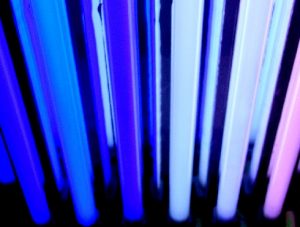
Six different brands of T5 lamps. Is there anything special about them? If so, what? This time, we’ll examine 3 different T5 lamps from UV Lighting.
Fluorescent Lamps
Introduced in the early 20th century, fluorescent lamps are a popular choice for lighting reef aquaria. They are available in a wide range of sizes and wattages and lumen output per watt of energy is about 2.5 to 3 times that of incandescent lamps and lamp life is much longer (as much as 20X that of incandescent lamp).
Fluorescent lamps are available in a variety of “outputs.” Standard fluorescent lamps are called Regular Output (or RO); these use ballasts rated at 425 milliamps (mA). High Output (HO) lamps require more current than RO lamps, but produce more light. HO lamps require 800 mA ballasts. Very High Output (VHO) lamps require 1,500 mA ballasts and produce more light than HO lamps.
Some of the newer electronic ballasts claim to overdrive RO and HO lamps to light outputs comparable to VHO lamps – we’ll examine this claim later in this series.
Fluorescent lamps are tubular glass envelopes containing argon (or krypton), a small amount of mercury and selected phosphors. Supplying adequate current to electrodes at the ends of the tube generates an electrical arc resulting in production of invisible ultraviolet (UV) energy, which excites, and is absorbed by, the phosphors. These phosphors then emit (fluoresce) the absorbed UV energy as visible light.
These lamps are most efficient at about 77° F., however, they are designed to operate at about 100° F. Light generation drops about 1% for every 2° F. rise in temperature above 77° F. This is due to the internal pressure of the lamp, which is directly related to light output – pressure is sensitive to temperature. A small fan might serve too purposes – light output is potentially increased if lamps are cool, and heat transfer to the aquarium water is decreased.
Markings on Fluorescent Lamps
Fluorescent tubes are generally marked with information at one end of the lamp. The ability to interpret these markings will provide valuable information.
Generally, the first marking designates the manufacturer or marketing agent. The next marking usually indicates the sort of lamp. Common markings for fluorescent lamps are “F”, “FR” for standard tubular lamps while Compact Fluorescent lamps are usually marked with “TT” or “PL” (depending upon manufacturer). These markings are followed by a number indicating wattage. Tubular lamps are marked with the diameter, usually as a “T”, followed by a number, indicating diameter in eights of an inch. For instance, “T8″ means the lamp diameter is 8/8ths, or 1″, and T12 means 12/8ths – the lamp is 1.5″ inches in diameter. Naturally, T5 lamps are 5/8” in diameter. The diameter may be followed by ballast requirements such as “HO” or “VHO.” Lamp Kelvin Temperature may be noted as 30 (or 3,000 K), 65 (6,500 K) or simply the Kelvin rating (10000), and so on.
Lamp Phosphors
Mixtures of phosphors within fluorescent lamps produce various light qualities. Phosphors that produce blue wavelengths include calcium tungstate and strontium chloroapatite. Blue-green and green are produced by barium titanium phosphate and zinc sulfate, respectively. Magnesium fluorogermanate produces red wavelengths (IES, 1984).
“Tri-phosphor” or “Tri-Band” phosphor lamps are available. This formulation of phosphors enhances the appearance of greens and reds by producing proper wavelengths which are reflected by the illuminated object. Tri-phosphor lamps have varying degrees of light production in the following portions of the spectrum: violet/blue, blue-green, green-yellow and orange-red. Compare the spectral differences in Figures 3 and 6 for an idea of enhanced green light production in a tri-phosphor lamp.
Lamp Lengths and Wattages
UV Lighting advertises their T5 lamps can be driven by ballasts of various outputs. For instance, the 34″ lamps tested for this review can be lighted by ballasts rated at either 39 watts or 60 watts. A 39-watt electronic ballast was used for these tests. Lamp length and suitable ballast wattages are listed in Table 1.
| Lamp Length | 22″ | 34″ | 46″ |
|---|---|---|---|
| High Output Wattage | 24w | 39w | 54w |
| Very High Output Wattage | 40w | 60w | 85w |
Be aware that lengths of these lamps allow them to be used in T5 luminaires of 24″, 36″ and 48″ in length.
Testing Protocol
I’ll explain how these tests were conducted for the truly dedicated. If you’re not interested in technical details, you can skip this section.
Spectral characteristics were measured using an Ocean Optics USB2000 spectrometer and 600 micron fiber optic patch cord (see here for a Product Review): http://www.advancedaquarist.com/2006/6/review/
Since the response of this spectrometer (or any spectrometer for that matter) is not perfect, raw data from the spectrometer were exported to Excel and post-processed using a program supplied by Charlie Mazel of NightSea, Inc. (http://www.nightsea.com). Basically, this correction of the spectrometer’s response enhances reporting of violet and blue portions of the spectrum. PUR, spectral composition and percentages were determined using a proprietary program in MS Excel.
Direct visualizations of the lamps’ spectral characteristics were determined by using an inexpensive handheld spectrometer and recorded with an Olympus C5050 digital camera in macro mode (see Figure 7, for example. See here for a Product Review of the inexpensive spectrometer): http://www.advancedaquarist.com/2006/7/aafeature/
Photosynthetically Active radiation (PAR) was measured with an Apogee quantum meter and compared against readings taken with a Li-Cor LI-192 quantum sensor in conjunction with a Li-Cor LI-1400 datalogger. The sensor was calibrated for ‘air’ measurements. (The measurements made for T5 lamps were the first for the LI-192 sensor since being refurbished by Li-Cor. This rebuild included replacing the photodiode and BNC connector, along with recalibration. The LI-1400 datalogger is brand new).
See here for a review of the Apogee PAR meter: http://www.advancedaquarist.com/2005/7/review/
Lux values were determined by a Gossen Luna Pro lux meter. In all cases, the lamps were positioned 3.5″ above the sensors by using a specially built jig. No reflector was used (but see Comments below). Voltage, wattage and amperage were measured with a P3 International Kill-A-Watt meter (See here for more information on the Kill-A-Watt meter): www.advancedaquarist.com/2008/7/short/
Figure 1 shows most of the equipment and experimental setup.
Lamps
This time, we’ll examine 3 popular lamps manufactured by Ultraviolet Lighting Company. These lamps are an Actinic White, Aquasun and Super Actinic. All are rated to be driven by 39 and 60 watts ballasts. All lamps were driven by a HO ballast for this testing. I have an electronic ballast on order and will investigate these lamps’ performance when driven at VHO currents later in this series.
Actinic White Lamp
- Advertised Lamp Wattage: 39 watts
- Amps (1 lamp): 0.29, including ballast
- Power Consumption (1 lamp, including ballast): 36 watts @ 118.7 volts
- Lux to PAR Conversion: Divide lux by 44 to estimate PAR
- Photosynthetically Usable Radiation (PUR): 82%
UV Lighting advertises Actinic White lamps to have a Kelvin rating of 12,000, and an expected life of 4,500 hours (which is ~1 year at a photoperiod of 12 hours per day).

Figure 2. The spectral power distribution of the Actinic White lamp. It appears to have a mix of phosphors used in Super Actinic and Aquasun lamps.
| Color | Percentage |
|---|---|
| Violet | 29.506% |
| Blue | 27.142% |
| Green-Blue | 3.642% |
| Blue-Green | 2.303% |
| Green | 0.762% |
| Yellow-Green | 15.500% |
| Yellow | 2.438% |
| Orange | 3.796% |
| Red | 14.910% |

Figure 4. A visualization of an Actinic White lamp’s spectral characteristics. Blue light has a fairly broad bandwidth, with a peak at ~436 nm. Note also the line spectra produced by the element mercury within the lamps (545 nm and a dual line at 577 and 579 nm).
Aquasun Lamp
- Advertised Lamp Wattage: 39 watts
- Power Consumption (including ballast): 35 watts @ 118.7 volts
- Lux to PAR Conversion: Divide lux by 50 to estimate PAR
- Photosynthetically Usable Radiation (PUR): 80%
UV Lighting (then URI) once advertised Aquasun lamps were best suited for freshwater planted aquaria, but this marketing strategy seems to have fallen by the wayside. With a Kelvin rating of 10,000, they produce less violet, but more red radiation than the Actinic White lamp. Again UV Lighting advertises an expected life of 4,500 hours (~1 year at a photoperiod of 12 hours per day).
| Color | Percentage |
|---|---|
| Violet | 10.821% |
| Blue | 40.559% |
| Green-Blue | 4.532% |
| Blue-Green | 3.193% |
| Green | 1.131% |
| Yellow-Green | 15.475% |
| Yellow | 2.543% |
| Orange | 4.154% |
| Red | 17.591% |
Super Actinic Lamp
- Advertised Lamp Wattage: 39 watts
- Power Consumption (including ballast): 36 watts @ 118.2 volts
- Lux to PAR Conversion: Divide lux by 44 to estimate PAR
- Photosynthetically Usable Radiation (PUR): 99%
Actinic lamps have been a mainstay in the reef aquarium hobby almost its inception during the 1980’s, and UVL has been one of the main suppliers to the North American market. Although the original concept for their use was simply to mimic the color of blue oceanic water, we are beginning to understand other advantages (such as high production of photosynthetically usable radiation).
UVL provides little information on the spectral quality of these particular lamps, but we should note that the Kelvin rating is extraordinary high and, even better, little red radiation is produced. However, Super Actinics by themselves make for a poor visual display except in cases where coral fluorescence is the goal. Hence, these lamps are most often used in combination with ‘warmer’ lamps in order that yellows, oranges and reds are highlighted.
| Color | Percentage |
|---|---|
| Violet | 69.318% |
| Blue | 26.031% |
| Green-Blue | 0.217% |
| Blue-Green | 0.229% |
| Green | 0.165% |
| Yellow-Green | 2.534% |
| Yellow | 0.592% |
| Orange | 0.108% |
| Red | 0.806% |

Figure 9. A visualization of a Super Actinic lamp’s spectral characteristics. Violet/blue light has a fairly broad bandwidth, with a peak at ~435 nm.

Figure 10. Our perception that the Super Actinic lamp produces blue light is partially true – it actually produces mostly violet light.
‘75.25’ Lamp
This is a brand name for a lamp marketed by UVL. Unfortunately, I was not able to obtain samples for testing. The 75.25 lamp (meaning 75% actinic and 25% Tri-Band Phosphor) is advertised as having a Kelvin rating of 14,000 K, and, as the advertisements say, “Adds vital life supporting properties”. I am unsure of exactly what ‘vital life supporting properties’means. I’ll try to obtain sample lamps and will comment further at a later date.
Lamp Combinations
Using fluorescent lamps in combination is more of a rule than exception, so I’ve included information on the spectral characteristics of an Actinic White and Super Actinic combo.
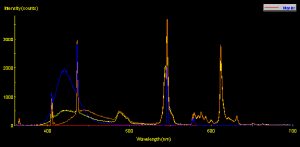
Figure 11. A comparison of spectral characteristics. Blue= Super Actinic; Yellow = Actinic White; Orange = AquaSun.
| Color | Percentage |
|---|---|
| Violet | 49.41% |
| Blue | 26.59% |
| Green-Blue | 1.93% |
| Blue-Green | 1.27% |
| Green | 0.46% |
| Yellow-Green | 9.02% |
| Yellow | 1.52% |
| Orange | 1.95% |
| Red | 7.86% |
| Color | Actinic White Percentage | Aquasun Percentage | Super Actinic Percentage | Super Actinic and Actinic White (1:1 ratio) Percentage |
|---|---|---|---|---|
| Violet | 29.506% | 10.821% | 69.318% | 49.41% |
| Blue | 27.142% | 40.559% | 26.031% | 26.59% |
| Green-Blue | 3.642% | 4.532% | 0.217% | 1.93% |
| Blue-Green | 2.303% | 3.193% | 0.229% | 1.27% |
| Green | 0.762% | 1.131% | 0.165% | 0.46% |
| Yellow-Green | 15.500% | 15.475% | 2.534% | 9.02% |
| Yellow | 2.438% | 2.543% | 0.592% | 1.52% |
| Orange | 3.796% | 4.154% | 0.108% | 1.95% |
| Red | 14.910% | 17.591% | 0.806% | 7.86% |
Photosynthetically Active Radiation (PAR) Output
Photosynthetically Active Radiation, or PAR, is the preferred method of measurement (as opposed to lux or lumens) when considering an application of a lamp for photosynthetic organisms.
The 3 UVL lamps were analyzed in accordance with the methods listed in the ‘Testing Protocol’ section (above).
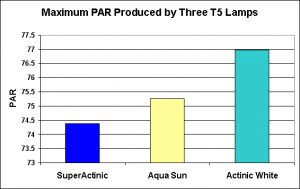
Figure 14. Light intensity (Photosynthetically Active Radiation, or PAR) produced by three UVL T5 lamps.
Importance of Sensor Positioning When Analyzing Fluorescent Lamps
Positioning of a sensor while making light measurements is one of many critical factors to consider when analyzing lamps, and so it is with florescent lamps. To this end, a special jig was built to allow precise and easily repeatable measurements when examining fluorescent lamps (see Figure 1). Figure 15 demonstrates the intensity variations that are common along the length of any fluorescent lamp.
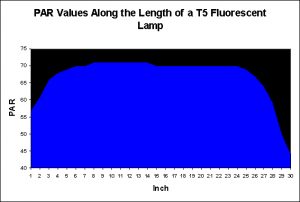
Figure 15. PAR measurements taken every inch along the length of a Super Actinic lamp reveals a rapid fall of light intensity near either end – this is typical of fluorescent lamps. The decrease in intensity to the right was caused by the manufacturer’s markings on the lamp. The sensor was 3.5″ below the lamp, and no reflector was above the lamp.
Effect of a Reflector on Light Intensity
Immediately apparent is the fact that a quality reflector can focus light into an aquarium. To judge the effects, a small parabolic, polished aluminum reflector especially designed for T5 lamps was clipped onto an Actinic White tube. PAR measurements were made before and after the installation. A ‘good’ reflector can efficiently focus light energy towards a target, while one poorly designed or installed is potentially of less use. Also consider that saltwater is corrosive to aluminum, hence one should take care to protect the reflector from salt spray via use of a glass or acrylic shield, or by waxing the aluminum with a quality car wax (or, preferably, both). See Figure 16 for an idea of how a reflector can focus radiation.

Figure 16. Effects of a reflector on light intensity. The quality of the reflector can make or break a lamp.
Photosynthetically Usable Radiation
Photosynthetically Usable Radiation, or PUR, is that portion of Photosynthetically Active Radiation (PAR) that is actually absorbed by photosynthetic pigments. Photopigments found in zooxanthellae of corals include chlorophyll a, chlorophyll c2 and peridinin. Typically, these pigments as a group absorb violet, blue and portions of the green wavelengths, as well as most red wavelengths. Since zooxanthellae can ‘tweak’ pigment ratios in response to light intensity and/or spectrum (within reason!), we can only generalize the wavelengths associated with PUR – for our purposes, PUR for corals and other animals containing zooxanthellae includes bandwidths of 400-550 nm (violet, blue and some green) and 620-700 nm (red).

Figure 17. Photosynthetically Usable Radiation (PUR) output of UV Lighting lamps. Note that the Super Actinic produced the least amount of PAR, but the most PUR (see Figure 14).
Ultraviolet Radiation Output
Since ultraviolet radiation is generated to excite the phosphors contained within the glass tube of fluorescent lamps, and the name of the company is UV Lighting, it would be logical to conclude that these lights produce ultraviolet radiation. In fact, these almost all UV radiation is absorbed by the internal phosphors or the glass tube. Hence, concerns about UV with these particular lamps are non-issues (but be aware that some T5 lamps – such as those marketed for use with reptiles and transmitting UV-A and UV-B – will generate significant amounts of potentially harmful radiation).
Comparison of T5 and T12 Lamps’ Output
T5 devotees often claim their lamps produce a great deal of light. But just how much better are they than regular T12 fluorescent lamps? Using the experimental setup shown in Figure 1, two Actinic White lamps of different wattages and lengths were compared. See results in Figure 18.
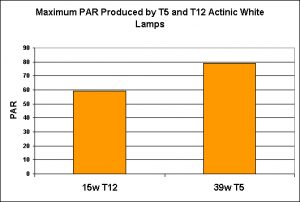
Figure 18. Although the lamp wattage is almost doubled, the T5 lamp produces roughly 25% more maximum light than a 15w T12 lamp. However, the T5 lamp’s length is about twice that of this particular T12 lamp.
Discussion
T5 lamps offer advantages and could be lamps of choice in certain applications. They can generate sufficient PAR and PUR to support just about any coral or other photosynthetic organism when used in multiples combined with appropriate reflectors. Although they produce light intensity only slightly greater than a standard 15-watt T12 lamp, their length and small diameters (thus allowing for more tubes per given area) make them attractive for narrow and/or shallow aquaria.
These lamps are available in a number of ‘colors’. As we begin to understand that violet and blue light is responsible for generation of certain fluorescent pigments within corals, and that red light may be responsible for regulation of zooxanthellae density and/or photosynthetic pigment content, it is important to understand the spectral characteristics of lamps and their potential effects on symbiotic invertebrates.
These lamps were obtained through normal retail channels – I got these at a good price from Coral Reef Ecosystems (www.coralreefecosystems.com). This concludes our discussion for this month. Next time, we’ll look at T5 lamps from Giesemann Aquaristic and ATI. Questions? Comments? Please contact me at [email protected].


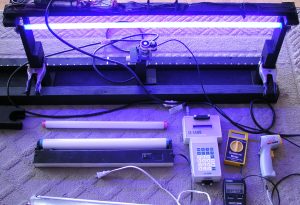

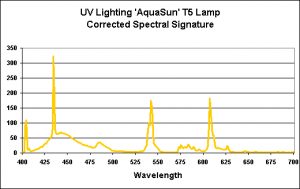


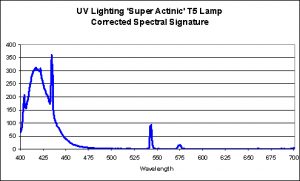

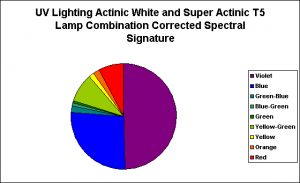

0 Comments